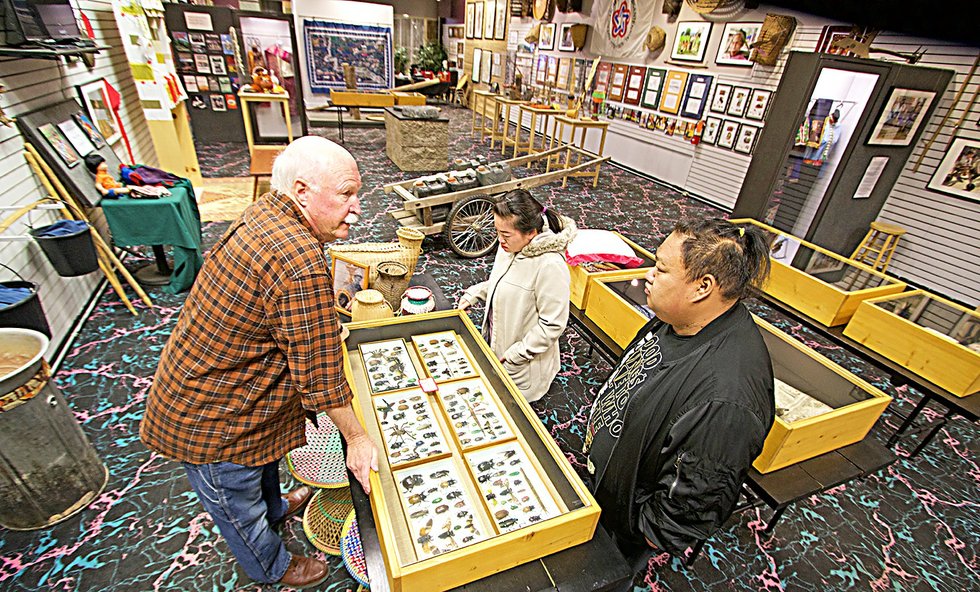(First published in the December 5, 2019 issue of City Pages)
Now three years old, the local museum about Hmong and Lao refugees has attracted school groups from across the state

Jim Harris, founder of the museum Laos to America: Honoring the Refugee Experience, walks a couple through the artifacts.
Nearly 9,500 people have come through the Laos to America Museum since it opened in November 2016 in Wausau Center Mall, including many student groups from school districts outside the area and from DC Everest. But as founder Jim Harris said in a speech at Wausau’s Hmong New Year event Nov. 2, he’s disappointed there has been no Wausau district elementary school class trips to the museum since its opening.
“I can’t pretend it doesn’t hurt,” he says. “I’ve tried hard to present something to the community. We get schools from other cities coming, people driving 100 miles or more to come here.”
It’s an especially hard sting because the age group Harris most would like to reach are the 8-year-olds, based on his decades as a professional educator.
Why is he hoping more 8-year-olds will come see things that would be encountered in everyday life in Southeast Asia? That’s the age where he, as a local teacher and principal, would see a child’s prejudices begin to emerge. That’s roughly the age—third graders—when white students at the lunch table would begin mocking their Southeast Asian classmates by jabbering in what they thought sounded like Chinese. That’s when, Harris observed, kids began to separate in groups according to ethnicity.
“The character traits at about 8 years old are the character traits you will see as an adult,” Harris says. “Does he have compassion, honesty and a sense of humor? Chances are he will have those traits as an adult.”
The museum, Laos to America: Honoring the Refugee Experience, is a storefront in the (former) JCPenney wing of the mall. Informally known as Wausau’s “Hmong museum,” it’s filled with artifacts and images that Harris and his wife, Marty, have collected over the years from Southeast Asia. Despite the large space, they don’t have the room to display everything he has brought back from his many visits to Laos since his retirement from the DC Everest school district. It is, as far as he knows, the largest collection in the U.S. of traditional Hmong and Lao artifacts.
Harris sees the museum as not only honoring the refugees who trekked across the world in order to survive, but also educational. One item on display is a handmade bird trap that’s triggered when a bird alights on what looks like a perch. Harris has taken many trips to northern Laos with much of his time leading teams to remove unexploded ordnance that date back to the Vietnam War era. One section of the museum holds tools and utensils the Laotians made using metal objects left from that conflict. Bomb parts are shaped into tools used to raise crops. Aluminum tubes from flares once used by the U.S. military are cut, flattened and hammered into items as domestic as a food-serving tray.
The museum can ease communications, he has found. In Hmong culture it is often frowned upon to talk about hard times, so Harris says, “It’s really nice when grandmas and grandpas come in with the kids. That’s when the best stories are told.”
The museum’s regular hours are 1–5 pm Saturday and Sunday. Admission is free. Contact Harris at 715-571-5165 or 715-355-1309
Special event Dec. 19
The Laos to America Museum will hold a video showing and Q&A Thursday, Dec. 19, in an event honoring the 500 people who came to Wausau from the Wat Tham Krabok refugee camp in Thailand. Museum founder Jim Harris went to Wat Tham Krabok in 2003 and made a video of life at the camp, where at one time 20,000 people were living on the 40-acre grounds of that monastery. Harris will show the video and answer questions afterward. The event begins 6:30 pm.




